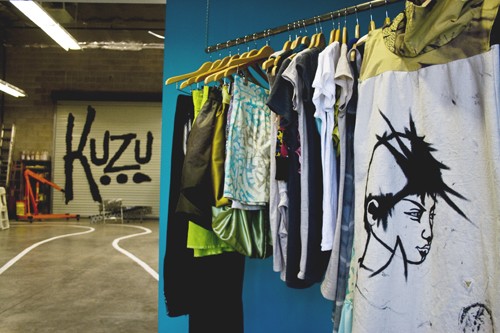After being closed all summer, Kuzu Salon reopened this past weekend for its “”Age of Aquarius”” art opening and fall fashion show, revealing months of hard work.
In reference to the event, co-owner and welding artist Hazel Coldwitz said, “”It was a huge success. There was at least 100 people. It was very fun … It was such a great event we actually had cops come by. … They said, ‘Is this a club? You have a club-like atmosphere going on here.'””
It’s not easy to classify Kuzu. It is simultaneously a clothing boutique, an art gallery, an artist workspace and it can be considered somewhat of a hideaway since it is located in remote South Tucson. Amidst a sea of beige and concrete typical of the area, Coldwitz’s minimalist sculpture by the front entrance is one of the only ways to distinguish Kuzu from the surrounding commercial buildings.
Though Kuzu is good at being mysterious, it is perhaps even better at being crafty.
“”I’d say at least 90 percent of everything we use is recycled in some way,”” said Laurel Burton, co-owner and clothing designer of Kuzu.
Most of Coldwitz’s art is made out of junkyard scraps, and the fashion show for their sustainable fall line was made from a previous show’s material. To make wearable, hangable and collectable products out of what normally appears to be nothing, takes passion, diligence and, to pull it off with Kuzu’s level of success, a bit of enchantment.
Heading inside Kuzu, mystery gives way to fascination. The space, suited for cultural hubs like New York or Los Angeles, is an oasis of art and fashion not normally found in Tucson.
Perhaps what makes Kuzu so special is that the three talented women who run it are family: Coldwitz is the mother of co-owners and sister designers Laurel and Mariko Burton.
“”We start with family and then expose it to everybody else and then just let it ride,”” Coldwitz said.
“”I think that, creatively, we work really well together,”” said Laurel Burton of the collaboration between her and her sister. “”My mom has always described us as being ‘night and day’ since we were little, and I think that in sharing a clothing line together that actually works … I see myself designing and creating with Mariko for a long time.””
The Burton sisters’ handmade clothing sits in the storefront. It’s a cutting-edge collection that despite being made by ‘night and day’ designers, comes across as consistent and fluid. Yet there are a couple of ways to tell one designer from the other. Laurel’s garments often have a feminine, pixie aesthetic, while Mariko’s style tends to be slightly darker and more avant-garde. This difference is welcome, since it diversifies the collection.
Among the impressive line of clothes and accessories, the storefront is decorated with Coldwitz’s salvaged junkyard art. On one end of the store is a rusty, salmon-orange plane body displaying Chicago-handmade cyclist hats in what used to be the plane’s windows. In the middle of the space, a beautiful pod-shaped sculpture featuring multi-colored metal petals attracts the eye.
Continuing through the storefront into the back of the warehouse, one can see that the space is filled with a wide array of influences and artworks. Virtually every nook of the salon has something visually stunning, from a large graffiti-inspired seahorse mural and more welded combine-sculptures in the warehouse to magazine clippings and small Japanese toys in the upstairs workspace.
“”It’s just a hodgepodge of things we like, things that inspire us, things that we think maybe one day we’ll use,”” said Laurel.
Amused, she continued, “”I think the three of us just pull all this out of our crazy brains.””









